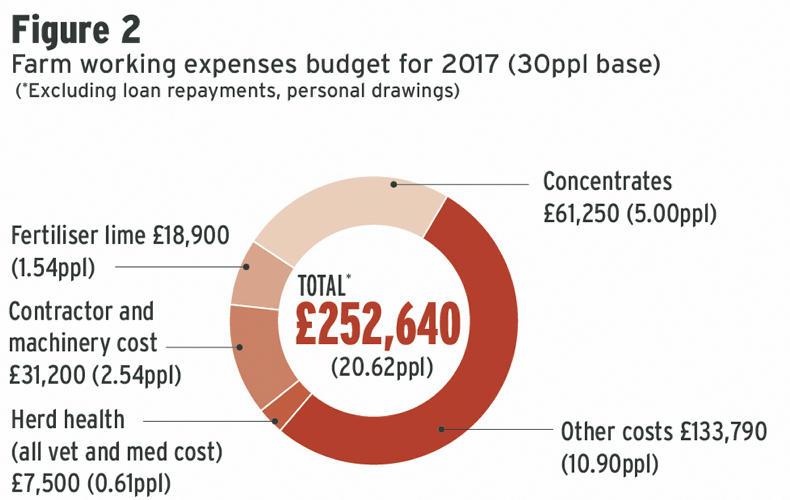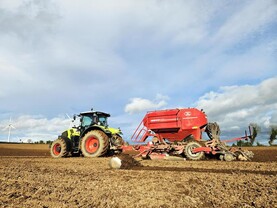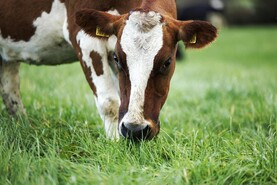Unlike many parts of the country, weather conditions in Tyrone made 2016 a battle for Robin Clements and family near Omagh. Robin was pleased to see a slight improvement in milk volume and prices in November and December, which helped the business balance the cashflow situation.
Output from milk sales totalled £226,750, with an average milk price received of 22.12ppl for all milk sold during 2016.
Other farm income from stock sales and agri-contracting work carried out by Robin and family represented £66,673. The contract element of this income is for all agricultural contract work completed during 2016.


From a cost perspective, Figure 1 highlights the top four costs recorded on the farm.
Robin has been proactive throughout the year in cutting costs and while he has not cut cost significantly in any one category, he has lowered cash production costs on the farm to 22.76ppl. This cost is before drawings and long-term loan repayments. When we include a personal drawing of £30,000 in the business, total farm expenses increase to £263,311 or 25.68ppl. This includes paid wages for both sons in the business.
Fertiliser and lime costs totalled £19,198. This allowed the farm to reach its target chemical nitrogen of 210kg/ha and also target low phosphorus and potassium indexed fields with compound fertiliser. The decision was made from the start of the year to focus on improving soil fertility and continue a reseeding push on the farm. During 2016, a total of 221t of lime was spread to improve soil pH and 65 acres have been reseeded (mostly on a purchased farm).
Purchased feed is still a major cost on this farm, coming in at £58,107. A total of 290t of dairy cow concentrate was fed, which equates to 1.8t/cow or a feed rate of 0.26kg/litre. An additional 21t of purchased feed was allocated to replacement heifers totalling £4,132 excluding milk powder fed to calves.
Machinery and contractor expenses consist of mainly machinery running costs, which include breakdown, maintenance and fuel cost for all machinery. This includes the fuel used for contract work and all machinery costs associated with the contracting side of the business.
What next for
Robin Clements?
We have about one third of the recently purchased new farm (two miles from home) reseeded. We have had to invest heavily in the grass, drainage and soil fertility on this new block of land to get it into good productive condition. Currently, this block is used for silage, heifers and zero-grazed grass for the milking cows at peak times when grass is in tight supply on the home grazing platform.
We are not zero-grazing throughout the year. I appreciate there is an added cost with hauling grass into cows, but zero grazing provides a short-term solution for the high stocking rate on the home farm, which will be in excess of four cows/ha for the 2017 season.
The ultimate solution for us will be to establish a milking herd on the new land block, but this will take time and money.
Breeding has been going well, with 55% in calf from the first three weeks of breeding. To push replacement numbers, I will continue to breed black and white for another two weeks this year, so 10 weeks rather than the usual eight weeks. This should push the number of replacements born next Sep/Oct to 47 head.
When I add machinery purchases and running costs for the farm, the cost is significant, coming in at around 3.8ppl.
While the majority of the cost is attributed to the contracting enterprise, it still provides the overall business with another source of income, adding approximately 4ppl to gross farm output.
It also allows our own silage and slurry work to be done in a timely fashion, which is important in this area with weather conditions and small windows of opportunity to get field work finished.
Both my sons and I have an interest in this work and, at the moment, the dairy business is just not large enough to fund all members of the family. As the dairy business expands, labour will become the limiting factor and will ultimately decide the future of the contracting enterprise.

Read more
Kerry sets January milk price
ICOS proposes new 'Irish milk' brand in context of Brexit
Unlike many parts of the country, weather conditions in Tyrone made 2016 a battle for Robin Clements and family near Omagh. Robin was pleased to see a slight improvement in milk volume and prices in November and December, which helped the business balance the cashflow situation.
Output from milk sales totalled £226,750, with an average milk price received of 22.12ppl for all milk sold during 2016.
Other farm income from stock sales and agri-contracting work carried out by Robin and family represented £66,673. The contract element of this income is for all agricultural contract work completed during 2016.


From a cost perspective, Figure 1 highlights the top four costs recorded on the farm.
Robin has been proactive throughout the year in cutting costs and while he has not cut cost significantly in any one category, he has lowered cash production costs on the farm to 22.76ppl. This cost is before drawings and long-term loan repayments. When we include a personal drawing of £30,000 in the business, total farm expenses increase to £263,311 or 25.68ppl. This includes paid wages for both sons in the business.
Fertiliser and lime costs totalled £19,198. This allowed the farm to reach its target chemical nitrogen of 210kg/ha and also target low phosphorus and potassium indexed fields with compound fertiliser. The decision was made from the start of the year to focus on improving soil fertility and continue a reseeding push on the farm. During 2016, a total of 221t of lime was spread to improve soil pH and 65 acres have been reseeded (mostly on a purchased farm).
Purchased feed is still a major cost on this farm, coming in at £58,107. A total of 290t of dairy cow concentrate was fed, which equates to 1.8t/cow or a feed rate of 0.26kg/litre. An additional 21t of purchased feed was allocated to replacement heifers totalling £4,132 excluding milk powder fed to calves.
Machinery and contractor expenses consist of mainly machinery running costs, which include breakdown, maintenance and fuel cost for all machinery. This includes the fuel used for contract work and all machinery costs associated with the contracting side of the business.
What next for
Robin Clements?
We have about one third of the recently purchased new farm (two miles from home) reseeded. We have had to invest heavily in the grass, drainage and soil fertility on this new block of land to get it into good productive condition. Currently, this block is used for silage, heifers and zero-grazed grass for the milking cows at peak times when grass is in tight supply on the home grazing platform.
We are not zero-grazing throughout the year. I appreciate there is an added cost with hauling grass into cows, but zero grazing provides a short-term solution for the high stocking rate on the home farm, which will be in excess of four cows/ha for the 2017 season.
The ultimate solution for us will be to establish a milking herd on the new land block, but this will take time and money.
Breeding has been going well, with 55% in calf from the first three weeks of breeding. To push replacement numbers, I will continue to breed black and white for another two weeks this year, so 10 weeks rather than the usual eight weeks. This should push the number of replacements born next Sep/Oct to 47 head.
When I add machinery purchases and running costs for the farm, the cost is significant, coming in at around 3.8ppl.
While the majority of the cost is attributed to the contracting enterprise, it still provides the overall business with another source of income, adding approximately 4ppl to gross farm output.
It also allows our own silage and slurry work to be done in a timely fashion, which is important in this area with weather conditions and small windows of opportunity to get field work finished.
Both my sons and I have an interest in this work and, at the moment, the dairy business is just not large enough to fund all members of the family. As the dairy business expands, labour will become the limiting factor and will ultimately decide the future of the contracting enterprise.

Read more
Kerry sets January milk price
ICOS proposes new 'Irish milk' brand in context of Brexit









 This is a subscriber-only article
This is a subscriber-only article













SHARING OPTIONS: